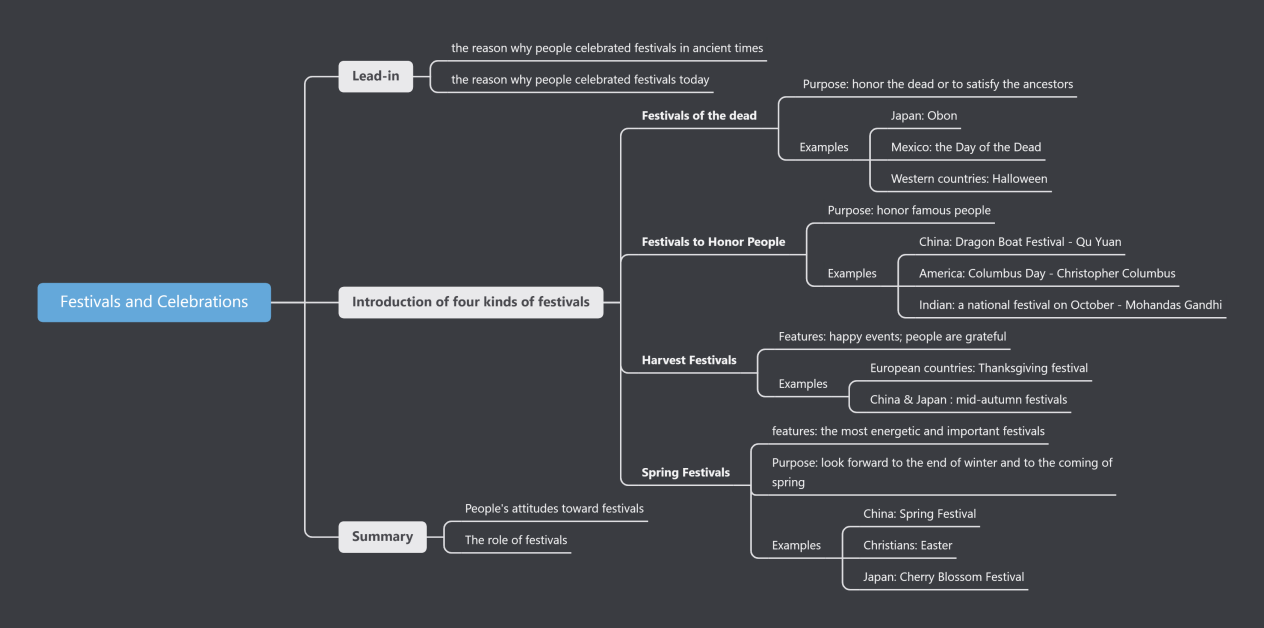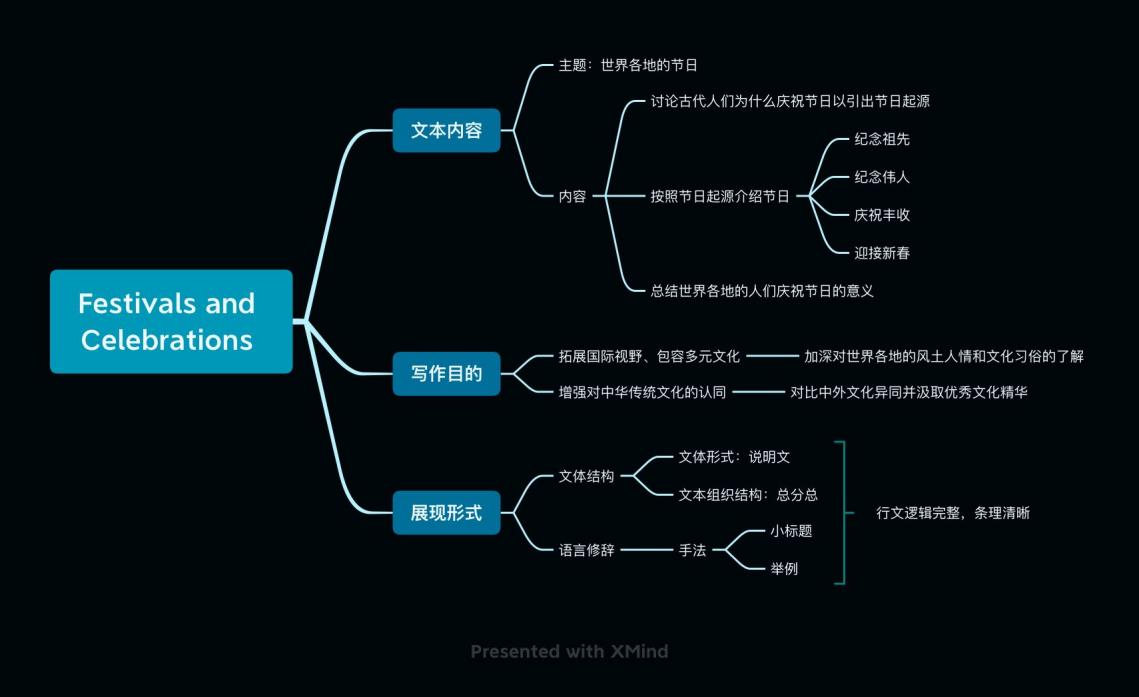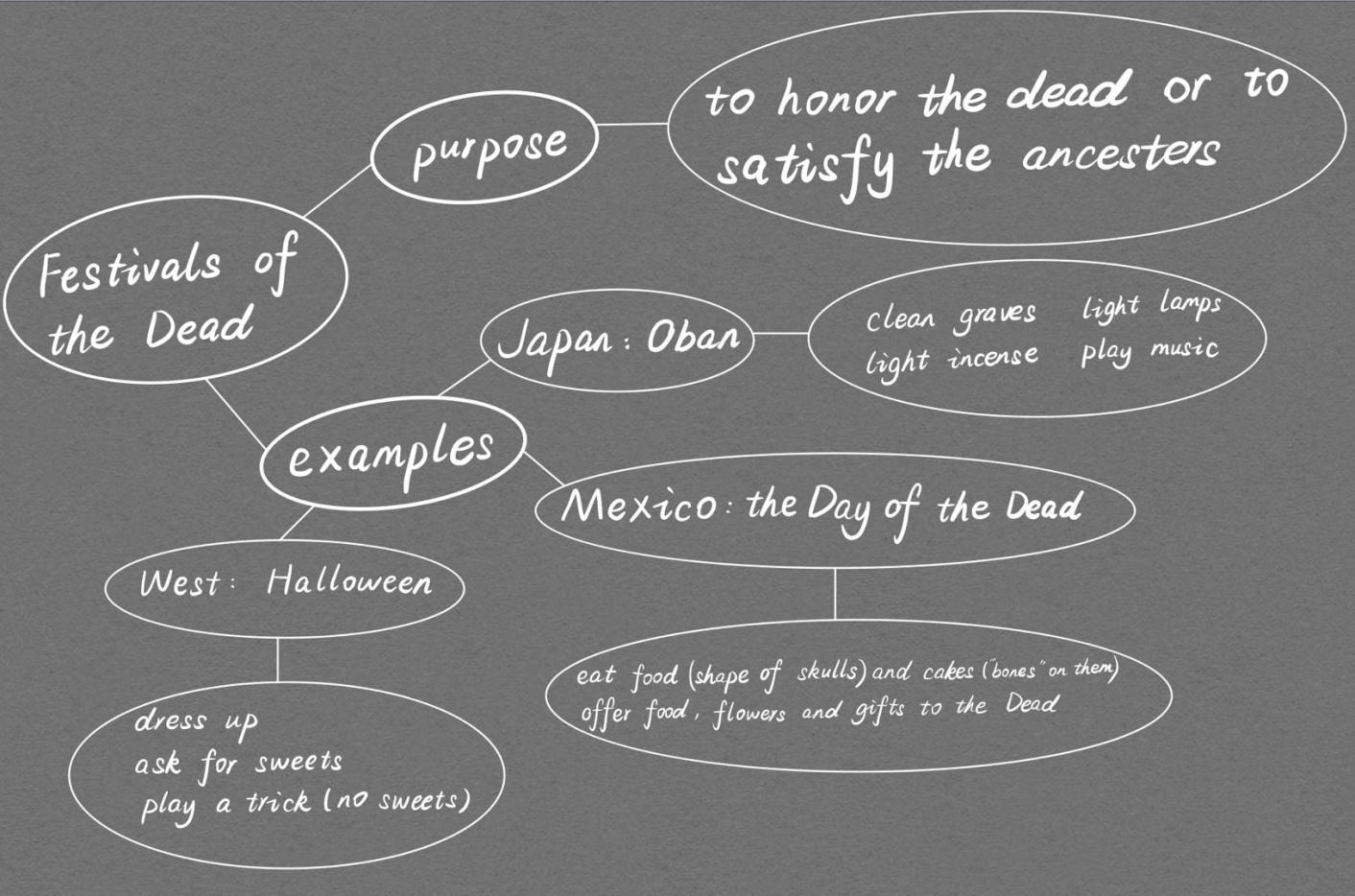-
G12 (Reading) Festivals and Celebrations
普通类 -
- 支持
- 批判
- 提问
- 解释
- 补充
- 删除
-
-
第12组 教学设计方案 第8次修改
课例名称
(reading) festivals and celebrations
课时
1
教学对象
高一学生
设计者
第12小组:
1192072013任昕雯;1192072017薛依宁;1192072012彭思恬
教材版本及单元
人教版英语必修三 unit1 festival around the world
学习内容分析


学习者分析
1.一般特征:
高一学生年龄在15-16岁,刚刚由初中升入高中,处在过渡的阶段。面临高中的新学习环境和知识,可能会感到不适应。在埃里克森的人格发展阶段理论中,他们处于青年初期(青春期),是形成自我同一性和价值观关键时期。随着年龄的增长,他们的自我意识明显增强,渴望独立思考。有部分学生可能会产生缺乏自信,孤僻等未建立好自我同一性的情况。根据皮亚杰的认知发展理论,高一的同学正处于形式运算阶段,思维水平已经与成人相近,基本具备抽象思维和系统思维,具有较好的推理假设总结以及分析的能力,能够回答较为深层次的问题,理解作者的真实意图。
2. 初始水平:
从认知结构上来看,高一学生对于话题有初步的了解,具有一定的中华传统文化知识,对英美国家的主要传统节日也有一定的了解。经过小学和初中的英语学习,高一学生能够吸收高中阶段的新知识并进行融合,原有知识的可利用性和可分辨性较强。但是缺乏整体性和系统性,缺乏对于中外传统节日的异同比较、文化传承的价值和意义方面的思考。
从认知基础上来看,高一学生能够掌握一些主要节日和习俗的英文名称,并能简单用英语对其进行描述,例如春节、元宵节、中秋节、端午节、圣诞节、复活节等,但是对于拉美地区或者其他东南亚国家的节日和风俗不是很了解,对于其英文表达掌握的不足。
3.学习风格
从认知方面看,高一学生能够在新旧语言知识直接建立联系,善于运用语境学习词汇,可以通过图表、思维导图等收集并整理信息,能够根据学习内容和学习重点,进行预习与复习。
从情感方面看,高一学生对英语学习有很大的兴趣和积极的态度,喜欢用英语来表达,对于自己的表达也有一定的自信,具有合作学习的意识。
从意志方面看,大部分同学能够用意志克服各种学习上的困难,但少部分同学仍然需要老师的督促和鼓励。
学习目标
1. 知识与技能:
①学生(a)能够在略读课文后(c)概括文章的大意(b),能够概括出本文按照追忆逝者、纪念伟人、庆祝丰收、迎接新春这四类介绍了世界各地的节日(d)。
②学生(a)能够通过寻读(c)找到老师要求的特定信息(b)。
③学生(a)能够以小组的形式(c)设计出课文每一小标题下的思维导图(b),至少可以完整设计出两个思维导图(d)。
2. 过程与方法:
①通过教师引导、小组合作、独立思考、表达交流等课文学习过程(c),学生(a)能够有逻辑地用英语阐述一个中国传统节日(b),至少能够介绍出该节日的名称、目的、庆祝方式,并表达自己对于节日的体验和感受(d)。
3. 情感态度与价值观
①学生(a)通过对课文中中外节日及习俗的学习(c),能够对比中国的主要习俗,尊重和包容文化的多样性(b),至少可以写一篇作文,总结出一个中国传统节日和一个外国传统节日在基本信息、历史或现实意义方面的异同(d)。
1. knowledge and skills:
① students (a) will be able to get the main idea of the text(b) after skimming the text (c). they at least should be able to generalize that the text introduces four kinds of festivals which are festivals of the dead, festivals to honor people, harvest festivals, and spring festivals.
②students(a) will be able to find specific information the teacher has asked (b) after scanning(c).
③students(a) will be able to work in groups(c) and design mind maps of each subheading of the text(b), and at least two mind maps can be designed in full(d).
2. process and method:
① through the text learning process of teacher guidance, group work, independent thinking and expression, and communication (c), students (a) will be able to explain one traditional chinese festivals in english logically(b), and at least they should be able to introduce the names, purposes and ways of celebrating their favorite festivals, and express their own experiences and feelings about them (d).
3. emotional attitude and values
① students (a) will be able to compare the main chinese festivals with festivals in other countries and develop respect for and tolerance of the diversity of cultures (b) through the study of chinese and foreign festivals and customs in the text (c), and at least they should be able to summarize the similarities and differences between one chinese and one foreign traditional festival in terms of basic information, history or current significance by writing a small passage(d).
教学重难点
教学重点:
①学生(a)能够在略读课文后(c)概括文章的大意(b),能够概括出本文按照追忆逝者、纪念伟人、庆祝丰收、庆祝新春这四类介绍了世界各地的节日(d)。
②学生(a)能够以小组的形式(c)设计出课文每一小标题下的思维导图(b),至少可以完整设计出两个思维导图(d)。
③通过教师引导、小组合作、独立思考、表达交流等课文学习过程(c),学生(a)能够有逻辑地用英语阐述自己一个中国传统节日(b),至少能够介绍出该节日的名称、目的、庆祝方式,并表达自己对于节日的体验和感受(d)。
④学生(a)通过对课文中中外节日及习俗的学习(c),能够对比中国的主要习俗,尊重和包容文化的多样性(b),至少可以写一篇作文,总结出一个中国传统节日和一个外国传统节日在基本信息、历史或现实意义方面的异同(d)。
① students (a) will be able to get the main idea of the text(b) after skimming the text(c). they at least should be able to generalize that the text introduces four kinds of festivals which are festivals of the dead, festivals to honor people, harvest festivals, and spring festivals.
②students(a) will be able to work in groups(c) and design mind maps of each subheading of the text(b), and at least two mind maps can be designed in full(d).
③through the text learning process of teacher guidance, group work, independent thinking and expression, and communication (c), students (a) will be able to explain one traditional chinese festivals in english logically(b), and at least they should be able to introduce the names, purposes and ways of celebrating their favorite festivals, and express their own experiences and feelings about them (d).
④students (a) will be able to compare the main chinese festivals with festivals in other countries and develop respect for and tolerance of the diversity of cultures (b) through the study of chinese and foreign festivals and customs in the text (c), and at least they should be able to summarize the similarities and differences between one chinese and one foreign traditional festival in terms of basic information, history or current significance by writing a small passage(d).
教学难点:
①学生(a)通过对课文中中外节日及习俗的学习(c),能够对比中国的主要习俗,尊重和包容文化的多样性(b),至少可以写一篇作文,总结出一个中国传统节日和一个外国传统节日在基本信息、历史或现实意义方面的异同(d)。
①students (a) will be able to compare the main chinese festivals with festivals in other countries and develop respect for and tolerance of the diversity of cultures (b) through the study of chinese and foreign festivals and customs in the text (c), and at least they should be able to summarize the similarities and differences between one chinese and one foreign traditional festival in terms of basic information, history or current significance by writing a small passage(d).
教学资源
黑板;粉笔;教材;幻灯片;投影;教案
教学环境
班级规模:40人;
座位模式:学生按照小组坐,4人组成一小组,小组成员将桌子拼起来
教学场所:宽敞明亮的教室;
班级气氛:团结友爱、积极向上
师生关系:温馨融洽
课堂教学流程
课堂教学分为三个部分:读前活动、读中活动、读后活动(读后活动包含布置作业)。(pwp模式)
读前活动:
教师首先创设一个情境,即自己的美国朋友jenny听了《明月几时有》这首歌曲后,十分喜欢,她知道这首歌曲是关于一个中国传统节日的,但是她不知道这个节日是什么,也不清楚这个节日的其他信息,她写信给教师,希望了解这个节日的相关信息以及一些中国传统节日,更希望能够了解一些中外节日的异同。因此,教师为学生播放这首歌曲的相关视频,让学生进行猜测,进而引导学生说出中秋节的其他信息,例如时间、目的、活动等,激发学生对于课堂的兴趣。紧接着,教师让学生以小组为单位,列举其他中国传统节日信息,以便回答美国朋友jenny的第二个问题。这个环节也是为了更好的激活学生背景知识。在这个过程中,老师的幻灯片上展示一些大家较为了解的节日的图片和英文名称,包括春节、元宵节、清明节、端午节、七夕节、重阳节,给予学生一定的支架,也避免学生都选取最为经典的春节、端午节等节日。然后,学生举手分享小组的讨论成果。
读中活动:
教师通过美国好友jenny的第三个问题,引导学生关注课文。因为前一天的作业是预习课文,概括文章大意并梳理结构,因此,教师采用直接提问的方式,让学生回答问题,并进行总结。接着,教师让学生阅读学案上面的问题,再次阅读文章并寻找答案。这个过程可以锻炼学生寻读的能力,同时学生在这个过程中可以进一步了解文章首尾段的具体内容。接着教师和学生一起仔细阅读文章的中间部分,即四个小标题的部分。教师带领学生绘制第一个小标题的思维导图以提供支架。紧接着教师让学生独立绘制思维导图。小组成员1绘制小标题二(festivals to honor people),小组成员2绘制小标题三(harvest festivals),因为第四个小标题(spring festivals)内容较多,因此小组成员3和小组成员4同时绘制这部分。
读后活动:
学生在小组内根据自己绘制的思维导图进行课文内容的复述,小组成员点评。然后,想要分享的同学在全班面前进行分享,老师进行点评。最后,老师引导学生思考不同国家的不同节日对于人们生活的影响,让学生意识到每一个的节日都可以让人们从紧张繁忙的工作中得到放松,让人们有机会享受美好的生活。这些节日都饱含人们对于美好生活的向往和对于本民族历史文化的热爱与自豪感。教师在引导学生比较鉴赏不同节日的过程中,让学生更好的理解包含不同文化,拓宽国际视野,形成正确价值观。最后的作业回归课程的情境设置,让学生给美国朋友jenny写回信,比较一个中国节日和一个外国节日。
教学过程(包含教学策略、教学评价)
教学环节
教学活动
设计意图
媒体资源的应用
教师活动
学生活动
step1:
pre-
reading
(6min)
1 teacher plays a video of the song bright moon how many time have and asks students to guess which chinese festival it is and inspires students to talk about more information of the festival. (情境教学)
(提问:my american friend jenny listened to a song and she knew it is about a chinese festival. she wants to know more about this festival and other traditional festivals. can you help her? )
2 teacher asks students to work in group of four and and list one chinese traditional festival in order to introduce it to jenny. teacher provides some festivals’ names and pictures on the ppt in order to help students. (情境教学、支架式教学)
3 teacher invites some students to share what they have listed.
1集体授课
2小组学习
3集体授课
1 students enjoy the video, guess the name festival and answer questions. (情境教学)
2 students work in group of four and list one chinese traditional festival including its name, the date or time it takes place, the purpose of it and how people celebrate it. (情境教学、支架式教学)
3 students volunteer to share what they have listed.
1集体授课
2小组学习
3集体授课
1 to arouse their interest in this lesson
2 activate their prior knowledge.
3 to activate the atmosphere of the class.
幻灯片视频
step 2:
while-
reading
(15min)
1 teacher asks students main idea and structure of the passage. teacher check with students.
(情境衔接:jenny wants to know more about the similarities and differences of festivals around the world? can you help her? maybe you can answer he according to what we learn from the passage. yesterday, i asked you to read as homework.)
(情境教学、讲授法)
2 teacher asks students to scan the passage and find the answer of following questions on their handout:
when did people celebrate festivals in the ancient times?
why did people celebrate festivals in the ancient times?
why do people celebrate festivals nowadays?
(讲授法)
3 teacher leads students to draw a mind-map about “festivals of the dead”by analyzing the part carefully.
(讲授法)
4 teacher divides students into group of 3(the last group has 4 students) and ask them to draw mind-maps of each paragraph under each subtitle on their handout.
student1:festivals to honor people;
student2: harvest festivals; student3(&student4 of the last group): spring festivals
(支架式教学)
1集体授课
2集体授课
3集体授课
4个别化学习
1 students tell the main idea and the structure of the passage according to what they read before class and then check with the teacher.
(情境教学、讲授法)
2 students scan the passage and find the answer of following questions on their handout:
when did people celebrate festivals in the ancient times?
why did people celebrate festivals in the ancient times?
why do people celebrate festivals nowadays?
(讲授法)
3 students draw a mind-map about “festivals of the dead”by analyzing the part carefully with the teacher.
(讲授法)
4 students are divided into group of 3(the last group has 4 students) and draw mind-maps of each paragraph under each subtitle on their handout.
student1:festivals to honor people;
student2: harvest festivals; student3(&student4 of the last group): spring festivals
(支架式教学)
1集体授课
2集体授课
3集体授课
4个别化学习
1 to foster their ability to get the general idea and find the structure of the text.
2 to foster their ability to extract required information from the text.
3 to help students have a better understanding of the text by leading them to finish the mind map and prepare them for finishing a mind map by themselves.
4 to promote their ability to analyze the text by letting them draw the mind maps by themselves.
幻灯片黑板
学案
step3: post-
reading
(19min)
1 teacher asks students to retell the paragraph in the group according to the mind-maps they have drawn, listen to other group members’ retell and voice opinions.
2 teacher asks students to share their retells in the whole class and the teacher makes reviews.
3 teacher inspires students to think about how different festivals in different countries influence people’ life.
4 teacher asks students to write a letter to jenny, comparing one traditional chinese festival and a festival in other countries as their homework. (情境教学)
1小组学习
2集体授课
3集体授课
1 students retell the paragraph in the group according to the mind-maps they have drawn, listen to other group members’ retell and voice opinions.
2 students volunteers to share their retells in the whole class and listen teachers’ reviews.
3 students think about how different festivals in different countries influence people’ life.
4 students write a letter to jenny, comparing one traditional chinese festival and a festival in other countries as their homework. (情景教学)
1小组学习
2集体授课
3集体授课
1 to foster their ability of retelling.
2 to facilitate their ability to speak in front of the class and make them more confidence.
3 to foster students’ ability to transfer by connecting the lesson with their life.
ppt
投影
教学评价
1 小组学习
评价教学评价形式:自我评价+他人评价
教学评价的工具手段:评价量规
教学评价内容:成员在小组内绘制的思维导图
准则 等级
及格
良好
优秀
全面性
涵盖文段的基本要点
涵盖文段的大部分要点
涵盖文段的所有要点
逻辑性
少量要点之间逻辑结构层次清晰
大部分要点之间逻辑层次结构清晰
所有要点之间逻辑层次结构清晰
美观程度
画面整体可观赏度不高,较为潦草
画面整体可观赏度较高,但是细节绘制较为潦草
整洁、美观、清晰
可推广程度
无法应用该思维导图的模式介绍其他节日
可以应用该思维导图的部分模式介绍其他节日
可以应用该思维导图的模式介绍其他节日
评价内容
自评
他评
指标
及格
良好
优秀
及格
良好
优秀
全面性
逻辑性
美观程度
可推广程度
2小组讨论
评价教学评价形式:自我评价+他人评价
教学评价的工具手段:评价量规
教学评价内容:成员做的汇报+对成员提的建议
内容 等级
及格
良好
优秀
成员做的汇报
全面的展示了思维导图的内容;但是口语表达不是很流利,存在语法错误,对内容理解产生一定的影响;存在较多单词发音错误,语调不自然
清楚、全面的展示了思维导图的内容;但是口语表达不是很流利,存在些许语法错误,但是不影响理解;存在较少单词发音错误,语调较为自然
清楚、流利、全面的展示了思维导图的内容;口语表达非常流利;单词发音完全正确,语调很自然
对成员提的建议
只是分享了自己的看法,对成员的汇报、导图进行点评
提出了一些建议,但是不具备可行性
提出了可供选择的建议,能让成员汇报或导图有所精进
评价内容
自评
他评
指标
及格
良好
优秀
及格
良好
优秀
成员做的汇报
对成员提的建议
板书

-
-
- 标签:
-
加入的知识群:


学习元评论 (0条)
聪明如你,不妨在这 发表你的看法与心得 ~